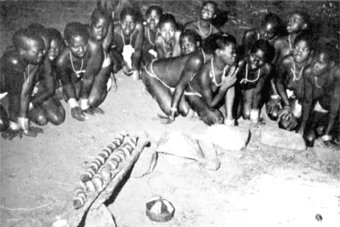|
During domba, the master of initiation arranged mimes or shows that were known as  . Though many of the . Though many of the  conveyed a particular lesson, they were also associated with entertainment. They were rarely shown more than once during a particular domba, attendance was not compulsory, and the action was generally done for the novices, who merely watched. conveyed a particular lesson, they were also associated with entertainment. They were rarely shown more than once during a particular domba, attendance was not compulsory, and the action was generally done for the novices, who merely watched.
 were almost always presented at night, after the performance of the domba dance. The novices were told to kneel down and hide their faces. Meanwhile the master would prepare the were almost always presented at night, after the performance of the domba dance. The novices were told to kneel down and hide their faces. Meanwhile the master would prepare the  (singular form of (singular form of  ) and his assistant would throw wood on the fire, to make it bright (unless darkness was essential for effect). When all was ready, the girls were told to sit up: they would either sing the song that accompanied the ) and his assistant would throw wood on the fire, to make it bright (unless darkness was essential for effect). When all was ready, the girls were told to sit up: they would either sing the song that accompanied the  or simply looked at was was shown to them. or simply looked at was was shown to them.
Phuse is an example of a  . Blacking claimed that when he asked for the meaning of phuse, I was always told,"phuse is phuse"! The word may be derived from -phusa = to wean a calf, and thus refers to the novices' final separation from childhood. Seeds of white, red, yellow and black maize (see colour symbolism) were placed on a small dome of clay, so as to form coloured sections, and an ostrich feather was stuck on top. While phuse was shown, the novices would sing Domba Song No. 6. . Blacking claimed that when he asked for the meaning of phuse, I was always told,"phuse is phuse"! The word may be derived from -phusa = to wean a calf, and thus refers to the novices' final separation from childhood. Seeds of white, red, yellow and black maize (see colour symbolism) were placed on a small dome of clay, so as to form coloured sections, and an ostrich feather was stuck on top. While phuse was shown, the novices would sing Domba Song No. 6.
| |

At this showing, three clay models were uncovered at the same time and shown to the novices. From left to right they are  haru (the python), khovhe-ya-vhimbi (the sea serpent, or eel), and phuse. Phuse is decorated with red, white and black grains of maize, and the other two with paint of the same colours. haru (the python), khovhe-ya-vhimbi (the sea serpent, or eel), and phuse. Phuse is decorated with red, white and black grains of maize, and the other two with paint of the same colours. |
|
Phuse was shown to remind the novices that it takes a long time for a girl to become fully nubile. The moon was associated with the onset of the menses. One master said that it should be nnyangawe, an abbreviation of nnyo ya nga iwe (your genitals).
|
To return, click 'Back' in the browser. |
|
